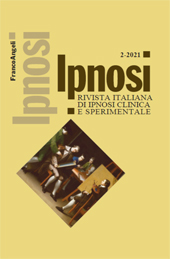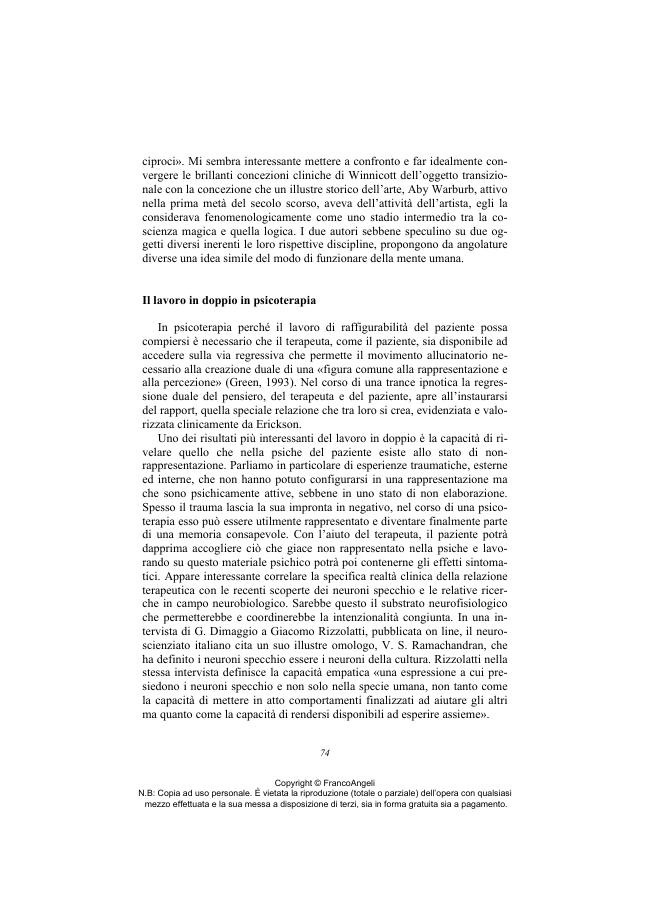La raffigurabilità psichica : il potere terapeutico e conoscitivo dell'immaginario
P. 69-79
La dimensione immaginativa ha una funzione fondamentale per la necessità che ha la mente umana di raffigurarsi il mondo esterno. Molti autori sostengono che uno dei compiti principali delle funzioni mentali è quello di creare le "immagini" del mondo, giungendo fino ai più elevati gradi di astrazione. Per fare questo è stato necessario, nel processo evolutivo, che si producesse accidentalmente un salto "qualitativo" che R. Thom chiama astrazione primordiale, che consiste nella capacità della mente di distanziarsi dalle percezioni sensoriali e di raffigurarsi im-maginativamente la realtà esterna. La raffigurabilità psichica è dunque una fun-zione mentale di base attiva massimamente nei fenomeni onirici, il sogno, e nelle visioni che spesso si producono ad esempio nello stato di trance ipnotica. Essa inoltre viene massimamente utilizzata nei processi mentali creativi sia nel campo artistico che in ambito scientifico.
Nella pratica psicoterapica utilizziamo spesso immagini o, in maniera più sofisticate, metafore per descrivere la realtà sia interna che esterna del paziente e induciamo a scopo terapeutico stati mentali regressivi: lo stato regressivo è inteso come una dimensione neuropsicologica della mente che facilita lo sviluppo dei fenomeni allucinatori e ideativi che sono alla base della capacità immaginativa dell'essere umano. Un fenomeno interessante in psicoterapia è che il terapeuta e il paziente possono condividere la via regressiva, grazie alla speciale relazione duale che si stabilisce: il rapport in ipnoterapia e il lavoro in doppio in psicoanalisi. Condividere non solo uno "stato mentale" ma anche quello che si produce in termini di raffigurabilità, come nel caso clinico che nell'articolo viene descritto. [Testo dell'editore]
The need for the human mind to figure or picture the external world is funda-mentally dependent on the imagination. Many authors hold that the ability to create "pictures" of the world, up to and including the highest degree of abstraction, is a fundamental component of our mental functions. For this to be possible, a qualitative leap ahead in evolution was needed to produce what R. Thom defines as the primary intuition, or the mind's ability to advance from simple sensorial perception to actually imagining external reality. This psychic figurability is hence a basic mental function which is highly active in dreamlike phenomena and in dreams, and in the visions which often arise in the hypnotic trance state. It is also massive-ly involved in the creative mental processes of the fields of both science and art. In the practice of psychotherapy, we frequently use images, or, more elaborately, metaphors, to describe both the internal and the external realities of a patient.
For therapeutical purposes, we also induce regressive states, a neuropsychological dimension that facilitates the development of the ideational and hallucinatory phe-nomena that underpin the human capacity to imagine. One interesting aspect of psychotherapy is that both the therapist and the patient can share this regressive pathway, thanks to the special dual rapport that arises in hypnotherapy, and the shared work of psychoanalysis. Not only the state of mind but also the product of psychic figurability is shared, as in the clinical case described in the article. [Publisher's text]
Ist Teil von
Ipnosi : 2, 2021-
Artikel aus derselben Ausgabe (einzeln erhältlich)
-
Informationen
ISSN: 1972-4985
KEYWORDS
- raffigurabilità, immaginario, illusione, dualità, trance ipnotica / regressione, rapport / lavoro in doppio
- figurability, imaginary, illusion, duality, hypnotic trance/regression, rapport/shared work of psychoanalysis



